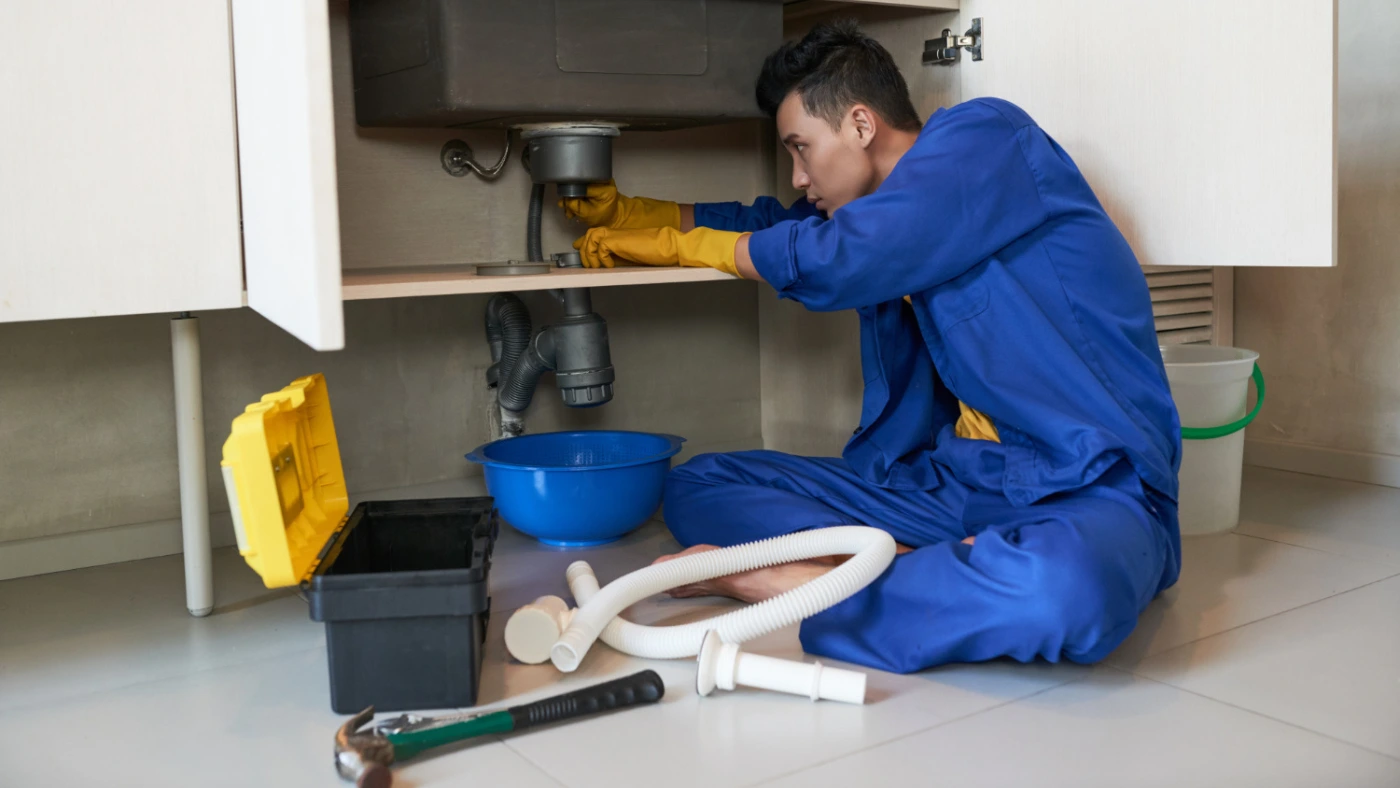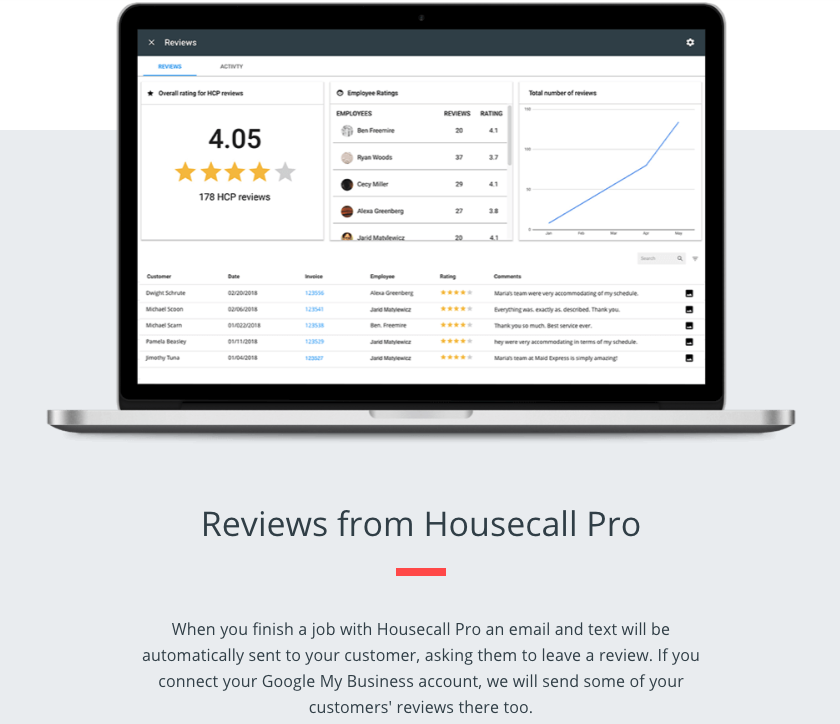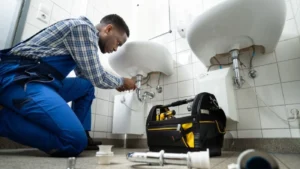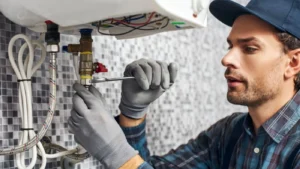Want to win more jobs with less effort?
Grow your business and send quick quotes with our home service software.

Want to see your potential revenue?
See what businesses like yours earn with Housecall Pro in 1 - 2 minutes.

These days, running a plumbing business means competing with more than just local plumbers. You also need to stand out against big companies that dominate Google search results. That can be frustrating, especially if you’ve tried online marketing campaigns that didn’t generate many leads. The good news? A strong plumbing SEO strategy can change that.
SEO (short for Search Engine Optimization) helps your business show up in front of the people who are actively searching for a plumber nearby. In this guide, we’ll walk you through 14 practical steps to improve your online visibility, attract more customers, and get your plumbing business noticed online.
Key takeaways:
Here's a quick overview of how you can help your plumbing business rank higher:
Claim your Google Business Profile: Make sure your listing is complete, verified, and includes accurate contact info, services, and hours.
Use local keywords: Add city or neighborhood names to your website titles, headers, and image alt text so nearby homeowners can find you.
Earn quality backlinks: Get listed on trusted directories and partner with local businesses to build credibility and authority.
Keep your website fast and mobile-friendly: A quick, responsive site improves user experience and helps your rankings in Google Search.
Plumber SEO services: Should you hire an expert?
Hiring a plumbing SEO agency can help you grow your business, but it’s important to weigh the pros and cons before investing.
Pros:
- SEO agencies have in-depth knowledge of competitive local markets.
- Specialists handle the more technical side of SEO—like fixing crawl errors or improving site speed.
- An agency has access to specialized SEO software you’d otherwise have to pay for.
Cons:
- Most SEO agencies charge a monthly retainer, typically between $1,000 and $2,500.
- Some use outdated black-hat tactics (i.e., shortcuts that go against Google’s rules), which can hurt your site long term.
- Long contracts can make it hard to switch providers if you’re unhappy.
- Some agencies use generic strategies that don’t fit the plumbing industry.
Whether you want to handle SEO in-house or hire an expert, understanding the basics will help you make the right choice.
Local SEO for plumbers
Local SEO helps your plumbing business appear in search results when people look for services near them—for example, “affordable plumber Dallas.”
Step 1: Optimize your Google Business Profile
Google Business Profile (formerly Google My Business) is a free listing that appears on Google Maps and Search. It lets you showcase your services and interact with customers before they visit your website.
To get started, go to Google Business Profile. Click “Start Now” and claim your business if it’s already listed. If it isn’t, follow these steps to create a new listing:
- Provide your business name and select the “Plumber” category.
- If you have a physical location, input your business address.
- Indicate whether you provide in-home plumbing services and select the areas you serve.
- Add your mobile number and website.
- Follow the on-screen instructions to verify your business.
- Select all the plumbing services you provide, from faucet installation to pipe repair and drain cleaning.
- Add your business hours so customers know when you’re available to work.
- Describe your business and upload photos of previous projects.
Once verified, your business can appear in “near me” searches when people in your area need a plumber.
Step 2: Use location-specific keywords
Location-based keywords ensure your web pages appear when people search for plumbers in your area. To rank for these results, include your city or neighborhood in strategic areas of your plumbing website, like the following:
- Page title: For example, “Emergency Plumber in Austin, TX | 24/7 Local Service”
- Meta description: For example, “Need a reliable plumber in North Dallas? We offer fast pipe repairs and drain cleaning for local homeowners.”
- Header tags such as H2s and H3s.
- Service page and blog post title: For example, “How to prepare your Houston home’s plumbing for winter.”
- Image alt text: For example, “plumber fixing a leaking faucet in Tampa.”
Pro tip: Keep the language natural. Google rewards clear, locally relevant content that sounds human, not robotic.
Step 3: Build local citations
A local citation is any mention of your business’s name, address, and phone number (NAP) on other websites. Apart from Google Business Profile, list your business on trusted directories like:
- Yelp
- Angi (formerly Angie’s List)
- Bing Places
- Nextdoor
- Better Business Bureau (BBB)
- Local chamber of commerce
- Facebook Business Page
Danny Wilcox, marketing manager at Carini Home Services, recommends aligning your listings with your Google Business Profile so customers see consistent information. Even small differences (like “St.” vs. “Street”) can confuse Google and hurt your local rankings.
Step 4: Get and manage customer reviews
Research shows that 85% of consumers trust online reviews as much as personal recommendations. This means every positive review builds credibility and boosts your visibility in local search results.
“Make reviews a habit from day one,” Wilcox says. “Have customers post photos of the [results] and mention the service and city where the work was performed.”
Here’s how to make reviews work for you:
- Ask for a review immediately after completing a plumbing job.
- Send customers a direct link to your Google Business Profile review page.
- Respond to every review (including negative ones) professionally.
- Showcase top reviews on your website, service pages, or social media posts as proof of great service.
Reviews also improve your click-through rates in search results and help you build relevance.Pro tip: With Housecall Pro, you can automate review requests so every customer gets a friendly message right after a job. It’s an easy way to collect more five-star reviews without extra effort.
On-page SEO for plumbers
On-page SEO means adding key signals to individual web pages to boost search rankings and improve the user experience. Here’s how to do it.
Step 5: Conduct keyword research
Keyword research is one of the best ways to get plumbing leads. It helps you understand what your customers are typing into Google when they need a plumber.
- Start with Google Keyword Planner: Log in to your Google Ads account, go to “Discover New Keywords,” and type phrases like “plumber near me” or “drain cleaning service.” You’ll see related keywords, search volumes (i.e. how much potential traffic you can get), and difficulty levels to rank.
- Use SEMrush or Ahrefs for deeper insights: Type your website or a competitor’s domain in the Keyword Overview tool to see keywords you currently rank for and gaps you can target.
- Filter for buyer intent: Look for transactional keywords with phrases like “repair,” “installation,” or “emergency,” which show a clear intent to hire a service.
- Include local modifiers: Combine service and location keywords such as “toilet repair Austin” or “water heater replacement Phoenix” to reach nearby customers.
Step 6: Create blog content
According to Sasha Berson, co-founder and chief growth executive at the marketing company Grow Law, creating content that directly answers common customer questions is one of the most reliable SEO strategies for plumbing companies.
Here are some examples of what to write about:
- Seasonal plumbing tips: “How to prevent frozen pipes in Chicago this winter.”
- Cost guides: “How much does it cost to fix a leaky faucet in San Diego?”
- How-to content: “What to do before calling an emergency plumber.”
- Local insights: “5 common plumbing problems in older homes in Boston.”
- FAQs: “Should I replace or repair a leaky pipe?”
Each post should sound like advice from a friendly expert and naturally link to your service pages. This helps readers (and Google) see you as a trusted local resource.
Step 7: Optimize page titles and meta descriptions
Your page title (also called a meta title) and meta description are what people see in search results before they click your website. They tell both readers and Google what your page is about—so make them clear and appealing.
Keep titles under 60 characters and descriptions under 160 characters so they don’t get cut off. Always include your main keyword and location.
Get inspired with these examples:
- Meta title: “Emergency Plumber in Denver | 24/7 Drain & Leak Repair”
- Meta description: “Need a fast, reliable plumber in Denver? Our licensed team offers 24/7 drain cleaning, leak repair, and water heater service. Call now for same-day help.”
Pro tip: Think of your meta description as a mini ad—it should make someone want to click.
Step 8: Use headers and structured content
Header tags (like H1, H2, and H3) help organize your content and make it easier for readers to skim. They also tell Google what’s most important on your page.
- H1: Your page title (only one per page).
- H2s: Major sections.
- H3s: Subtopics under each section.
- H4s: Extra detail (used sparingly).
You can also use bullet points, numbered lists, and tables to make content easier to digest. A well-structured page keeps readers engaged longer, which sends a positive signal to search engines that your page is useful.
Step 9: Optimize images
Rename files with descriptive, keyword-rich names (such as austin-drain-cleaning.jpg instead of IMG_1234.jpg). Add alt text that clearly describes what’s in the photo; this helps search engines understand your images and improves accessibility for visually impaired users.
Follow these additional tips:
- Use TinyPNG to reduce file size without losing quality.
- Use WebP format for faster loading.
- Include relevant local keywords in the alt text.
Optimized images make your site load faster, which improves both your SEO and your customers’ experience.
Step 10: Improve website speed and mobile experience
A 2024 Hotjar survey found that 70% of visitors leave slow-loading websites. Since most homeowners search from their phones, your site needs to load quickly and look great on any device.
Here’s how to make that happen:
- Test your site with Google PageSpeed Insights or GTmetrix to identify slow-loading elements.
- Turn on browser caching (which stores parts of your site so it loads faster next time).
- Use a responsive design that automatically adjusts to any screen size.
- Choose simple, easy-to-read fonts and plenty of white space.
The best plumbing websites load quickly and have clean designs, leading to higher rankings and a better first impression with customers.
Off-page SEO for plumbers
Off-page SEO is everything you do outside your website to build credibility and authority. This includes backlinks (links from other websites) and community engagement. The more trustworthy your online reputation, the better your rankings.
Step 11: Build quality backlinks
Backlinks are links from other websites pointing to yours. Think of them as votes of confidence in your business. According to Backlinko, top-ranking pages have nearly four times as many backlinks as lower-ranking ones.
Here’s how to earn quality backlinks:
- Get listed in local directories.
- Write guest posts for home improvement blogs or local news sites about plumbing maintenance tips.
- Partner with plumbing supply companies or contractors.
- Join industry associations like the Plumbing-Heating-Cooling Contractors Association.
Focus on earning backlinks from relevant and trustworthy sources, as low-quality links can damage your reputation.
Step 12: Engage on social media
Social media doesn’t directly affect search rankings, but it increases brand awareness and drives more people to your site. Pick one or two platforms where your customers spend time—Facebook, Instagram, or even Nextdoor—and post consistently. Share before-and-after photos, short repair videos, or quick maintenance tips.
You don’t have to be a content creator or have fancy equipment to create engaging social posts. Ivan Vislavskiy, CEO of Comrade Digital Marketing Agency, says the most effective social content is “simple, authentic, and service-focused.”
One plumbing company he worked with started posting short before-and-after repair videos on Facebook and Instagram. When they paired these with location tags and ads, they received more inquiries and phone calls. In one case, a $20 ad generated three bookings.
Step 13: Partner with local businesses
Collaborating with other local businesses helps you reach new audiences and earn local mentions or backlinks. Look for noncompeting businesses serving the same community.
Try these plumbing marketing ideas:
- Co-host a home maintenance workshop with HVAC techs or electricians.
- Sponsor a neighborhood event or charity run.
- Offer referral deals with real estate agents or property managers.
These collaborations build brand recognition, strengthen community ties, and improve local SEO for plumbers.
Step 14: Monitor online reputation
Google pays attention to how people talk about your business across the web, not just in reviews. Manage your online reputation by following these steps:
- Set up Google Alerts for your business name and key team members.
- Use a social listening tool like Sprout Social to track brand mentions.
- Respond professionally to all reviews.
- Encourage satisfied customers to leave feedback on Google, Yelp, or Facebook.
A solid reputation signals to Google and potential customers that your plumbing business is trustworthy. This trust turns into clicks, calls, and more clients.
Learn more: How to respond to negative reviews
Technical SEO for plumbers
Technical SEO might sound intimidating, but it just means making your website easy for search engines to read and understand. Here’s how to get the basics right:
- Check indexing and crawlability: Submit your XML sitemap to Google Search Console, check for crawl errors, and fix broken links.
- Add structured data (schema markup): Add plumbing-specific schema for services, business info, and reviews. For example, include LocalBusiness and Service schema to help Google display your business details in search results.
- Use HTTPS: HTTPS encrypts the connection between your website and a visitor’s browser, protecting their data. Google also treats this as a ranking factor.
- Optimize site architecture and internal linking: Keep your site organized with a clear hierarchy and link related pages. This helps users and search engines navigate easily.
- Fix technical errors affecting performance: Improve page speed, ensure mobile responsiveness, and resolve duplicate content or canonical issues. These factors directly affect rankings and user experience.
- Audit regularly: Every 3-6 months, run a full-site audit using Google Search Console or Screaming Frog to catch and fix issues before they hurt performance.
How to measure SEO success
To know whether your plumbing SEO is paying off, you’ll need to track your performance over time.
Track key metrics
There are plenty of SEO metrics to track, but not all of them tie back to business growth. Focus on key performance indicators (KPIs) that directly impact visibility, leads, and revenue. For plumbers, these are the most important metrics:
- Website traffic: Monitor how many people visit your website, both through paid ads and search engines.
- Local rankings: Track your position for primary keywords. If someone searches for “cheap plumber near me” and you’re at the top, that means more local leads.
- Click-through rate (CTR): See how many people click your link when it appears in search results.
- Bounce rate: This shows how many visitors leave after viewing just one page. A high bounce rate can mean your webpage didn’t meet their expectations or loaded too slowly.
- Conversion metrics: Measure how many visitors call, fill out a contact form, or request a quote after landing on a page.
Check these figures monthly to spot trends and adjust your strategy.
Use SEO analytics tools
Google offers free tools like Google Analytics and Google Search Console to help you track how customers find and interact with your plumbing website. Analytics shows which pages and marketing channels drive the most leads, while Search Console reveals your top-performing keywords and any site issues that need fixing.
Interpret data and adjust strategies
SEO isn’t a “set it and forget it” process. Review your data regularly, spot what’s working, and double down on it.
If “drain cleaning services in Chicago” brings in lots of traffic, create related blogs, videos, or service pages to strengthen that topic. If a page isn’t converting, tweak your call to action (CTA) or add trust signals like reviews or certifications. Small, consistent improvements add up to keep your plumbing business growing.
How Housecall Pro’s plumbing software can help
Housecall Pro gives you the tools to turn your online presence into a steady source of leads and repeat customers. From collecting reviews to tracking performance, our platform makes it easy to manage and grow your plumbing business all in one place.
With our plumbing software, you can:
- Collect feedback with automated review requests that build trust.
- Convert website visitors into customers with online booking forms.
- Track business metrics in one unified reporting dashboard.
- Drive repeat business with automated follow-ups that keep your brand top of mind.
- Integrate customer data to personalize future marketing efforts.
Ready to simplify your marketing strategy and boost your SEO? try Housecall Pro free for 14 days.







